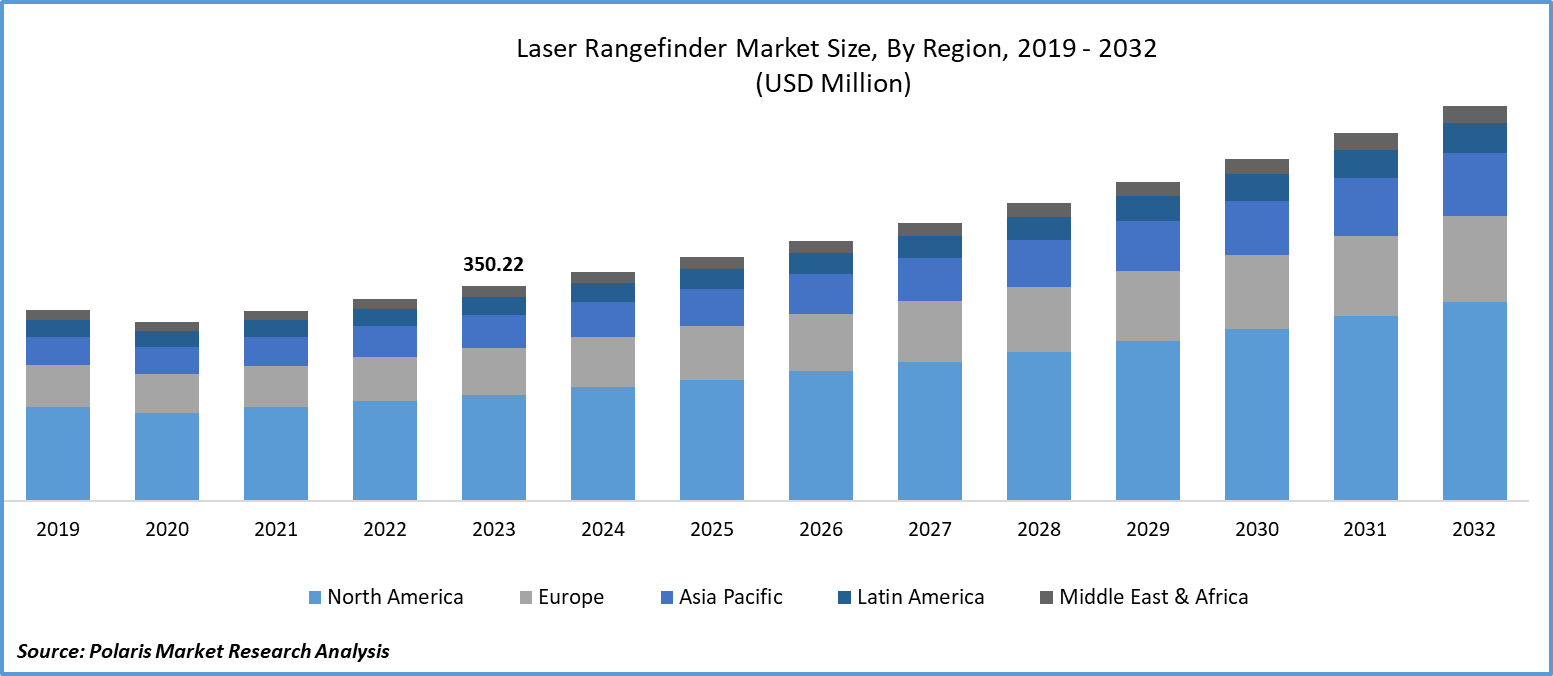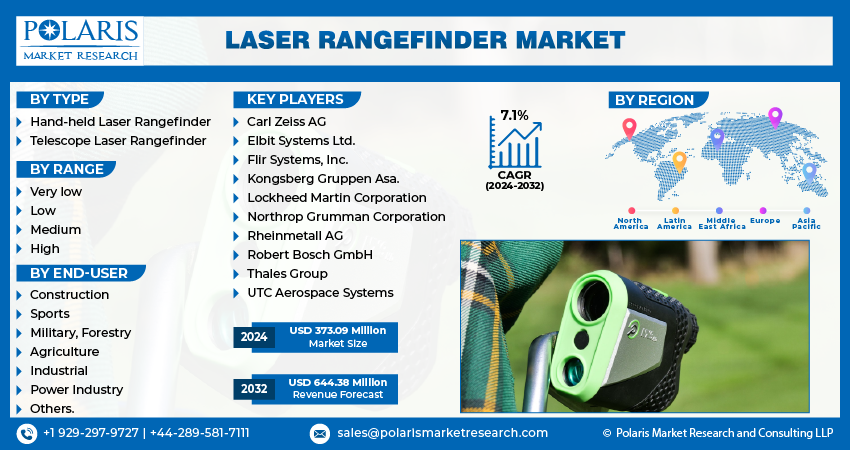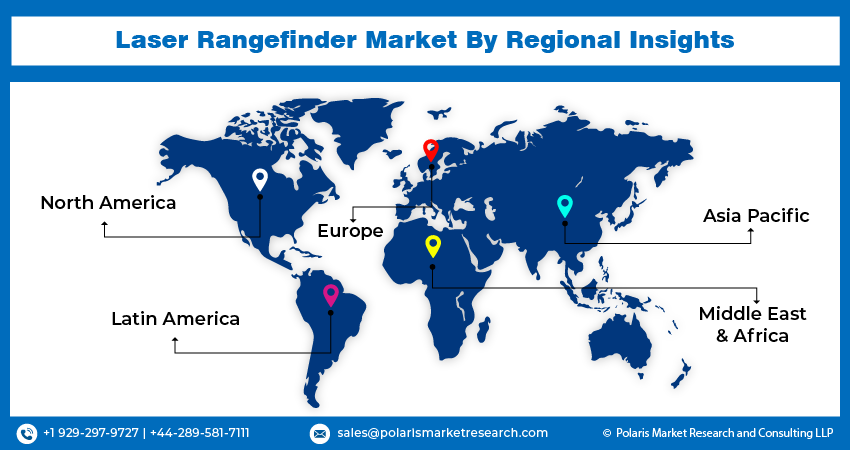
Laser Rangefinder Market Share, Size, & Industry Analysis Report
By Type (Hand-held Laser Rangefinder, Telescope Laser Rangefinder); By Range; By End-User; By Region; Segment Forecast, 2025 - 2034
- Published Date:May-2025
- Pages: 145
- Format: PDF
- Report ID: PM1451
- Base Year: 2024
- Historical Data: 2020-2023
The global laser rangefinder market was valued at USD 3.2 billion in 2024 and is forecasted to grow at a CAGR of 14.60% from 2025 to 2034. Growth is driven by increased applications in defense, sports, and industrial automation.
Laser Rangefinder Market Overview
The laser rangefinder market is rising due to the rising global focus on enhancing defense equipment. Due to the increasing need for state-of-the-art, very accurate equipment in a wide range of industrial processes and the equipment's widespread application in surveying, navigation, and photography, the market is expanding at a quicker rate. It is also impacted by the growing number of defensive system upgrades that use rangefinders, as well as the growing need for rangefinders to improve accuracy during athletic events.

To Understand More About this Research: Request a Free Sample Report
For instance, in February 2024, the Indian Central Government announced an investment of USD 12.05 billion to encourage the development of deep tech for the defense sector and boost the domestic ecosystem's research into disruptive technologies.
Manufacturing had a crucial role in COVID-19 lockdowns, especially in the production of military laser rangefinders by corporations. The output rate fell precipitously. A shortage of cash and raw materials significantly impacted the overall growth. Additionally, the nation's economic recovery took up a large portion of every nation's budget, and comparatively few military laser designators and laser finders were included in the defense budgets. Both growth rates and market demand fell to all-time lows.
However, the digital laser rangefinders is expanding rapidly in North America, Asia Pacific, Europe, and the USA, among other places. APAC is anticipated to grow at fastest CAGR because of the growing uptake of cutting-edge technology and its adoption in nations like China and India.
Laser Rangefinder Market Dynamics
Market Drivers
Rising in Consumer Demand
There is a rise in the demand for laser range field by consumers due to its wide applications in various industries, including military defense, construction, sports, automotive, robotics, geospatial, and many more due to continuous advancements such as increased size, precision, and range, the industry is expanding. Improved features, including multiple target measurements, faster reaction times, and higher durability, attract users from a wide range of industries. All this expansion is to produce cutting-edge technologies to cater to infrastructural development to ensure precise distance measurements, multiple target measurements, better durability, and faster response time. For instance, in June 2023, Altechna, a Laser systems developer, planned to expand its technological and cleanroom facility in the US by investing more than USD 8.7 million in research and development to meet the rising consumer demands.
Rise in Advancement in Technology
There is ongoing research and development to support market expansion by improving laser rangefinders. The producers are spending capital on research and development to create sophisticated, lightweight machinery. Over the forecast period, the equipment market will grow due to increasing technical advancements, equipment integration with commercial unmanned aerial vehicles, and growing demand from emerging economies. These elements are anticipated to accelerate overall growth. For instance, in February 2024, SpaceX and Intuitive Machines tested a laser range finder technology at Spaceport America, which will help lunar vehicles navigate the lunar surface area for safe landing. The purpose of thorough research and development is to develop, design, and test integrated devices to yield lightweight and low-cost time-of-flight laser rangefinders.
Market Restraints
Hurdles Which are Likely to Impede the Growth
There are various factors affecting the growth of the laser rangefinder market, including the expensive cost of it due to their increased functions and features. Strictly adhering to the production and development process makes it more complex. It may not always be as accurate when used in uncertain weather or on highly reflective surfaces. As technologies are always advancing, there is a competitive threat from alternative technologies such as ultrasonic rangefinders, and GPS-based systems. Further, safety is a major concern, when applied they are potentially harmful to human eyes; hence, adhering to safety standards and procedures is mandatory. Its complexity of integration makes it difficult for any modification or alterations owing to new technological advancements.

Report Segmentation
The market is primarily segmented based on type, range, end-user, and region.
|
By Type |
By Range |
By End-User |
By Region |
|
|
|
|
To Understand the Scope of this Report: Speak to Analyst
Laser Rangefinder Market Segmental Analysis
By Type Analysis
- The telescope laser rangefinder segment has dominated the market in 2024 due to its ability to measure distance very precisely at a range of several hundred meters. They can produce measurements in a couple of seconds and are also incredibly quick. Additionally, using it is quite simple and requires little training. Its applications include distance-based golf club selection, surveying, navigation, aiding with photographic focus, and adjusting projectile weapon aim for distance.
- The hand- held laser rangefinder segment is expected to grow at the fastest growth rate over the next coming years due to its ability for not requiring stereoscopic techniques to do the correlation of characteristics from two pictures in order to obtain depth information. The depth resolutions of it used in computer vision applications are 0.1 mm or less. It may be used to track or gauge item lengths or distances. Additionally, they are able to deliver positional information without actually touching the observed item across vast distances. In sports, hunting, and the military, hand-held laser range finders are frequently utilized.
By Range Analysis
- Medium-range laser rangefinders dominated the market share in 2024 due to their ability to permit quick distance measurement between the field and the object of interest. Moreover, it has wide applications in military, forestry, sports, industrial processes, 3D modeling, and laser measuring tools.
- The high-range laser rangefinder is anticipated to grow at the fastest CAGR due to its wide application in construction, mining, sports, and industrial processes, where it provides accurate measuring results.
By End-User Analysis
- The military segment has dominated the market share due to its ability to improve the precision with which infantry, artillery, rockets and missile, and armored vehicle weapons may be targeted. Improved technology and advanced research and development are owing to the dominance of this field due to its ability to carry out target-seeking and surveys in order to raise situational awareness. They could feature thermal imaging capabilities in addition to day and night vision modes.
- The construction segment is anticipated to grow at the fastest CAGR owing to the adoption of the latest technologies for businesses in the construction sector for its great range accuracy and practical measurement. It is capable of measuring the non-contact distance between an object's surface and a reflected target, having air-cooled water-cooling mechanisms, lens purging devices, and adjustable mounting brackets to work better in high-precision, non-direct touch applications. This has significantly led to a decrease in labor time and expenses, being an economically viable approach.
Regional Insights
The North America laser rangefinder market is accounted for the largest share attributed to the growing need and adoption of advanced machinery. The need for sophisticated machinery in the military is becoming more and more necessary as the defense sector uses more vehicle-mounted devices. The need for military laser rangefinders is also increasing due to the development of electronic warfare.
The Asia Pacific laser rangefinder market is expected to witness fastest CAGR during the projected period, owing to a sizable population and a growing economy. The promotion of domestic manufacturing by the governments of developing nations is expected to stimulate economic growth.

Competitive Landscape
The laser rangefinder market is fragmented and is anticipated to witness competition due to several players' presence. Major service providers are constantly upgrading their technologies to stay ahead of the competition and to ensure efficiency, integrity, and safety. These players focus on partnership, product upgrades, and collaboration to gain a competitive edge over their peers and capture a significant share.
Key Players
- Carl Zeiss AG
- Elbit Systems Ltd.
- Flir Systems, Inc.
- Kongsberg Gruppen Asa.
- Lockheed Martin Corporation
- Northrop Grumman Corporation
- Rheinmetall AG
- Robert Bosch GmbH
- Thales Group
- UTC Aerospace Systems
Recent Developments
- In January 2025, the COOLSHOT PROIII STABILIZED Laser Rangefinder was launched by Nikon Vision Co., Ltd. It featured HYPER READ technology for faster measurements, Dual LOCKED ON QUAKE, and a stabilized lens, enhancing golfers’ accuracy and ease of use.
- In November 2023, MBDA Deutschland announced the launch of the latest laser weapon demonstrators (LWDs). These LWDs are capable of both ground-based and naval applications and will become functional laser-based operational systems in 2027.
- In May 2023, Lumibird was all set to acquire Convergent Photonics, a subsidiary of Prima Industries, to develop high-power fiber lasers applicable in the medical sector.
Report Coverage
The laser rangefinder market report emphasizes on key regions across the globe to provide better understanding of the product to the users. Also, the report provides insights into recent developments, trends and analyzes the technologies that are gaining traction around the globe. Furthermore, the report covers in-depth qualitative analysis pertaining to various paradigm shifts associated with the transformation of these solutions.
The report provides detailed analysis of the market while focusing on various key aspects such as competitive analysis, type, range, end users, and their futuristic growth opportunities.
Laser Rangefinder Market Report Scope
|
Report Attributes |
Details |
|
Market size value in 2024 |
USD 3.20 billion |
|
Revenue forecast in 2034 |
USD 12.5 billion |
|
CAGR |
14.60% from 2025 – 2034 |
|
Base year |
2024 |
|
Historical data |
2020 – 2023 |
|
Forecast period |
2024 – 2034 |
|
Quantitative units |
Revenue in USD billion and CAGR from 2025 to 2034 |
|
Segments covered |
By Type, By Range, By End-User, By Region |
|
Regional scope |
North America, Europe, Asia Pacific, Latin America, Middle East & Africa |
|
Customization |
Report customization as per your requirements with respect to countries, region, and segmentation. |
FAQ's
key companies in Laser Rangefinder Market are Flir Systems, Inc., Kongsberg Gruppen ASA., Lockheed Martin Corporation
Laser Rangefinder Market exhibiting the CAGR of 14.60% during the forecast period
The Laser Rangefinder Market report covering key segments are type, range, end-user, and region.
key driving factors in Laser Rangefinder Market are rise in advancement in Technology
The global laser rangefinder market size is expected to reach USD 12.5 billion by 2034

